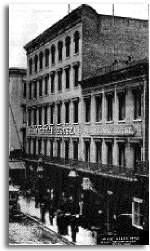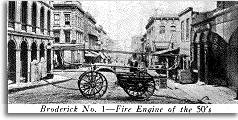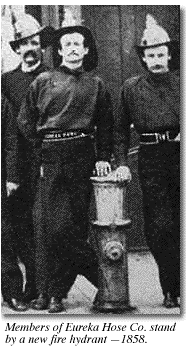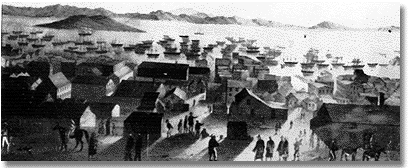|
||||
|
||||
|
|||||||||||||||||||
This article of random facts about 1856 San Francisco life appeared in the Diamond Jubilee Edition of the "News Letter." A big sand hill covered the middle of Market Street, from Kearny to Dupont, in the days of '50. Passengers went up Geary to Dupont [now Grant Ave.], then to the edge of the sand hill on Market, where a milk wagon could just pass, leading to St. Anne's Valley. Large sand hills running east and west -- between them St. Anne's Valley. Some of the water front streets had wharves. Many large vacant lots were filled with water from the bay.  In 1856, residents were
just beginning to build houses with bath- In 1856, residents were
just beginning to build houses with bath-Street lamps lighted the main streets in 1853. Whale oil and kerosene oil were used. The streets were largely paved with 4-inch planks 16 to 24 feet long. A few cobblestones streets were very useful in winter, when the mud was in some places to the knees. Sidewalks were generally of planks. Some few brick and stone sidewalks. No cement sidewalks. The Western Addition in 1856 extended as far as Leavenworth street. Beyond were milk ranches. Pacific street was the only one cut through. Jackson street and Washington street were not opened beyond Taylor street. Omnibuses provided carriage from North Beach to South Park. Street car lines were then unknown. There were no cables or horse cars. A daily stage went to San Jose and way stations. The Embarcadero was at what is now Redwood City. In 1856 there was only one house on the slough there. Mission street, beyond Forth and Fifth streets, was a toll road to the Mission. It was a plank road all the way. The Pioneer race track, a mile track, was beyond the Mission. Many vacant lots were in the vicinity, covered with beautiful wild flowers. Large water wagons furnished water to houses. Each house had a barrel in the kitchen to be filled. Few houses were piped with gas or water.  Parlors had large chandeliers with two or three rows of glass
prisms, containing wax candles.
Parlors had large chandeliers with two or three rows of glass
prisms, containing wax candles.
Whale oil was generally burned. Large candles in high silver candlesticks were used in bedrooms. Steamboats ran to Sacramento and vicinity. The Democratic party was everywhere in power.  Fire engines were hauled by men, with long ropes; there were one
hundred men on each side and brakes were worked by men on each
side of engine. Fire engines were hauled by men, with long ropes; there were one
hundred men on each side and brakes were worked by men on each
side of engine.
There were no elevators in buildings. Quite a number of Mexican adobe houses were still in existence in San Francisco, particularly at the Mission Dolores. The Willows and Nightingale House, at Sixteenth street and beyond were places of resort. Correspondence was largely through Wells- Newspapers consisted of blanket sheets of four pages. There was no overland telegraph. Steamers sailed once in thirty days from New York, by way of Panama. Clipper ships carried freight arrived via Cape Horn in ninety days-- considered a quick trip. Local banks used scales to buy gold dust. A pinch of gold dust paid for a pie at a bakery. There was a hack [cab] stand around the Plaza, where hacks could be hired. San Francisco's population was about 30,000 in 1856. Photographs were practically unknown. Daguerrotypes were taken of individuals and localities. No stationary wash stands in the San Francisco houses. A wash stand with a bowl and pitcher furnished personal washing facilities. Gentlemen generally dressed in silk hats called "beavers," and wore boots and long Prince Albert coats. Ladies wore hoops.  The extension of Commerical street into the bay was called "Long
Wharf," where passengers were landed in boats from incoming
vessels. The extension of Commerical street into the bay was called "Long
Wharf," where passengers were landed in boats from incoming
vessels.
The County of San Francisco extended to San Francisquita Creek, until June 11, 1856, when the city and county of San Francisco was formed, extending to the southern end of Lake Merced, and south of that a new county was formed called San Mateo County, out of the remainder of the County of San Francisco. San Francisco News Letter December 5, 1925 |